Easy to Grow Low Light Aquarium Plants Nano
BuildYourAquarium.com is supported by our readers. When you buy through links on our site, we may earn a commission. Learn more.
Starting a planted aquarium in your home can be an engaging and rewarding hobby.
Since you may not be willing to invest in the full setup that high intensity light plants need, a low light aquarium is a great way to get your feet wet without spending too much up front.
For the purpose of this guide, plants that require 3 watts per gallon of light or less are what I consider to be low light plants.
With so many choices of aquatic flora and fauna, how does a beginner choose the right plants? We've created a comprehensive list of the top 30 low light aquarium plants, ideal for beginners and experienced fish-keepers alike.
Because each aquarium (and aquarist!) is unique, there is no "one size fits all" plant species to select for your aquarium.
For that reason, this list includes a handy scoring system which ranks each plant based on their light level required, level of care required, and compatibility with other plants and fish.
Additional Reading: 5 Best Planted Aquarium Lights on the Market

A Few Supplies That You May Need
While none of the species on our list require too much additional care, these products may be helpful (especially if you want to attain good growth in a low light environment!)
- Root Tabs: Root tabs are small, nutrient-packed discs placed under the substrate to help with nutrient levels. I highly recommend Seachem Root Tabs. I've found these to be the best on the market.
- Liquid fertilizer: Liquid fertilizer should be used more sparingly than root tabs, as it can tend to cause algae outbreaks. That said, Seachem Flourish is great for propelling growth in aquarium plants that don't root into the substrate.
- Seachem Flourish Excel: Typically, heavily stocked planted tanks require expensive, complicated CO2 systems. Seachem Excel, though, helps deliver all the same benefits without expensive setups. I would really recommend picking up a bottle, especially for low-light setups.
I know we are talking about "low-light" setups here, but I alsohighly recommend the NICREW Classic LED Light to anyone looking for a cheap, effective light. It is definitely the best deal you can get for your money.
Keep in mind that each of these products should be used sparingly. In any planted aquarium, it's important not to over fertilize.
But low light aquariums are especially prone to algae because most low light aquarium plants grow slowly. But algae can easily outpace their growth, leading to problems down the road.
Special Considerations
If its your first time growing low light aquatic plants, you're in luck! Each of the plants here are fairly easy to care for. They need little in the way of fertilization, lighting, CO2 supplements, and are generally hardy as far as water conditions are concerned.
- When choosing and arranging your plants, think in terms of background, midground, and foreground elements. Tall plants like African Water Ferns or mature Java Ferns make great background plants. Middle height plants like Cryptocoryne or Anubias balance out the edges of the scene as midground plants. And your foreground is home for smaller, sometimes creeping plants like Rotala.
- Ease up on the fertilization in a low light tank! With some exceptions like Hornwort, most of the plants here are not the fastest of growers. Adding too much in the way of nutrient growth can cause explosive algae growth if your plants can't uptake it all at once.
- Additional research on the specific care requirements of your plants are important. pH is critical to proper plant health; plants like Marimo Moss balls do well in slightly alkaline water (pH 7+), while others like Java Fern prefer more acidic pH climes (pH below 7).
30 Best Low Light Aquarium Plants for Beginners
Here are a few species of low-light aquarium plants that we recommend for beginners:
1. Java Moss (Vesicularia dubyana)

Java moss is a very common moss that grows naturally on rocks and trees in tropical climate zones. It lacks roots, meaning that the moss can float through the water to gain any nutrients it needs.
However, it will also attach itself to aquarium décor or substrate. Java moss is characterized by its tiny oval shaped leaves, which are useful for obscuring unattractive aquarium equipment such as filters.
The moss will easily adhere to any porous surface, making it perfect for décor.
Java moss is a slow grower but requires little additional attention as it filters the nutrients it needs directly from the water through its leaves. Size can vary greatly; the moss can be molded into various shapes or used in a mat, so the size is up to you.
Just know that it can get out of hand if not kept well groomed; other aquatic moss species like Christmas Moss may suit your needs better if you prefer something more tidy.
- Light level required: Low, but more light can be provided to encourage growth. Too much light will lead to overgrowth.
- Level of care: Beginner
- Compatibility: Excellent. Makes great cover for small fish, invertebrates, eggs, and live young. Prefers being attached to rocks and other hard surfaces and does not root well in gravel.
2. Green Hygro (Hygrophila polysperma)
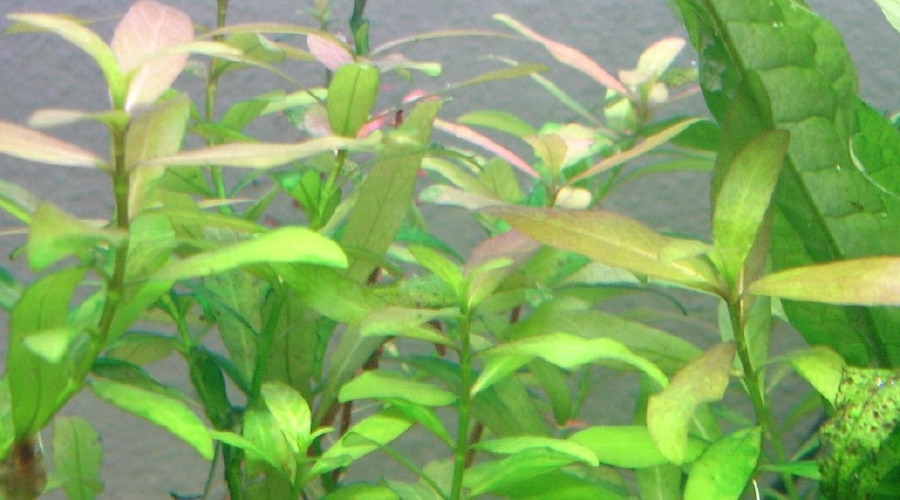
The green hygro is a rapid growing stem plant with long leaves, which may vary from green to brown to red depending on the lighting provided. This plant prefers a substantial substrate in order to anchor its roots, so make sure to pick out a good planted aquarium substrate. In order to prevent browning, only low lighting should be used. Due to the prolific growth of the green hygro, it is considered a weed and is prohibited in some states. Check local laws before acquiring the green hygro for your aquarium. The green hygro is a prolific plant and can get out of control when it's especially happy with a setup. CO2 boosts can also help it along but aren't strictly necessary.
- Light level required: Low, browning will occur with overlighting. Rapid growth will occur even in very low light.
- Level of care: Beginner-Intermediate
- Compatibility: Good, but must be pruned often in order to prevent it from taking over. Avoid using in tanks with goldfish, as they will likely over-feed on the plant and kill it rapidly.
3. Sunset Hygro (Hygrophila polysperma 'Rosanervig')

The sunset hygro is a close relative of the green hygro, with the main difference being the coloration of the leaves. The sunset hygro has red-pink leaves with white veins. Like the green hygro, it must be pruned often with pruning scissors or simply pinching off new growth by hand. In addition, in order to maintain the bright red hues of its leaves the water must contain appropriate levels of iron.
Both red and green varieties are great indicator plants in a low light aquarium. If nutrient levels or other issues arise, they tend to drop their leaves, signalling a problem.
- Light level required: Low-moderate light.
- Level of care: Beginner-Intermediate
- Compatibility: Good, but must be pruned to avoid taking over the tank.
4. Rotala Rotundifolia

The rotala rotundfolia is a recognizable aquarium plant known for its pink coloration and narrow rounded leaves which, when allowed to grow to the surface of the water, will cascade downward in a bushy growth pattern.
This plant is another example of a rapid growth plant which requires the proper lighting to achieve optimal coloration. Like hygros, it must also be pruned often in order to avoid overgrowth. Rotalas generally do not exceed 6" in width, but will continue to grow vertically and climb the sides of the aquarium.
It's worth mentioning that while Rotala Rotundifolia will tolerate and even thrive in a low light aquarium, it only shows its pink hue when given brighter lighting.
- Light level required: Moderate. Too-low light will result in yellow-green leaves. Can flourish as a low light plant as long as sufficient micronutrients are provided.
- Level of care: Beginner-Intermediate
- Compatibility: Good, but must be pruned in order to avoid prolific growth.
5. Rotala Indica

Rotala indica (Indian Toothcup) is closely related to the rotundifolia, with only a few minor differences. The indica has more rounded leaves which tend to stay green regardless of lighting conditions, while only the stem of the plant presents a reddish hue. Both species can be planted individually or in a small bunch, but will require heavy pruning. Additionally, the indica does not require as much light as the rotundifolia in order to maintain its coloration, nor does it grow as quickly.
- Light level required: Low.
- Level of care: Beginner-Intermediate.
- Compatibility: Good, but must be pruned in order to avoid prolific growth. And requires less light compared to Rotala rotundifolia.
6. Hornwort (Ceratophylum demersum)

Hornwort has a unique foliage pattern which gives the plant its nickname of "Coontail". Leaves grow outwards in numerous shoots which give the appearance of a bushy tail. The hornwort is bright green in color, and does not have true roots meaning it does not require a solid substrate. It will attach itself to objects in the aquarium, or may float freely in the water. Hornwort grows quickly and provides a good habitat for newborn fish.
- Light level required: Low-moderate
- Level of care: Beginner
- Compatibility: Excellent
7. Java Fern (Microsorum pteropus)

The java fern is a versatile, ideal plant that prefers low light aquariums. Java ferns are slow to grow at first, but will gradually begin to spread across the aquarium, eventually attaining a height of 12-14" and a width of approximately 6". The leaves of the java fern can vary greatly across varieties, and are generally long and thin. Java ferns can thrive when anchored to the bottom of the tank by gravel, or by floating in the tank, where it will eventually find an object to anchor its roots to. The java fern is a hearty plant that does not require special lighting, but should not be subjected to overly harsh lighting.
- Light level required: Moderate to Low lighting
- Level of care: Beginner
- Compatibility: Excellent
8. Parrots Feather (Myriophyllum aquaticum)

Lush green foliage with a unique texture makes the parrot's feather stand out among aquatic plants. Parrot's feather is popular for its use as a shade and hiding material for aquatic animals. Like hornwort, this plant tends to float in the water, but can be anchored using a shallow substrate.
- Light level required: Moderate to high, which can be achieved by having the aquarium close to a window in addition to the use of low lighting within the tank.
- Level of care: Beginner
- Compatibility: Excellent, especially with goldfish, guppies, and minnows.
9. Moneywort (Bocapa monnieri)
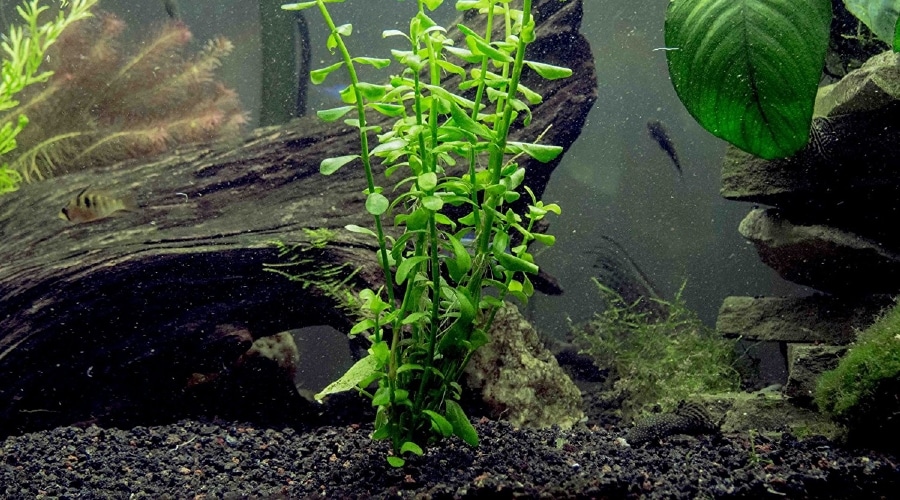
The moneywort is a creeping plant known by many names and commonly used to add to the color of the aquarium. The moneywort has small, oblong leaves bright green in color that grow upwards along sturdy stalks. Shoots of moneywort are often planted close together to create contrast amongst other plants. Moneywort tends to grow vertically, achieving heights of approximately 6-8".
- Light level required: Moderate.
- Level of care: Beginner
- Compatibility: Excellent, thrives in most aquarium environments.
10. Brazilian Pennywort (Hydrocotyle leucocephala)

The leaves of the Brazilian pennywort are light green and bean shaped branching from vine-like stems. Like many others, this plant can be kept as a floating plant or can be rooted to the substrate. The pennywort is a rapid growth plant that must be pruned often, but is worth the effort as it is a very attractive plant and can be used anywhere within the aquarium.
- Light level required: Any, but low is sufficient to hinder overgrowth.
- Level of care: Beginner
- Compatibility: Should not be included in tanks with goldfish or cichlids, as it can be a relatively delicate plant.
11. Crypt Wendtii

Crypt wendtii is a highly variable plant species which can exhibit brown, red, or green leaves in various textures and sizes. Generally, the leaves are long with waved edges, and the leaves can reach lengths upwards of 18". The crypt wendtii is a popular plant due to its versatility and may be used as a focal point within the aquarium.
- Light level required: Thrives in any lighting conditions.
- Level of care: Intermediate. Highly sensitive to changing conditions within the aquarium.
- Compatibility: Good but should not be included in tanks with cichlids who may tear up the leaves.
12. Crypt Balansae
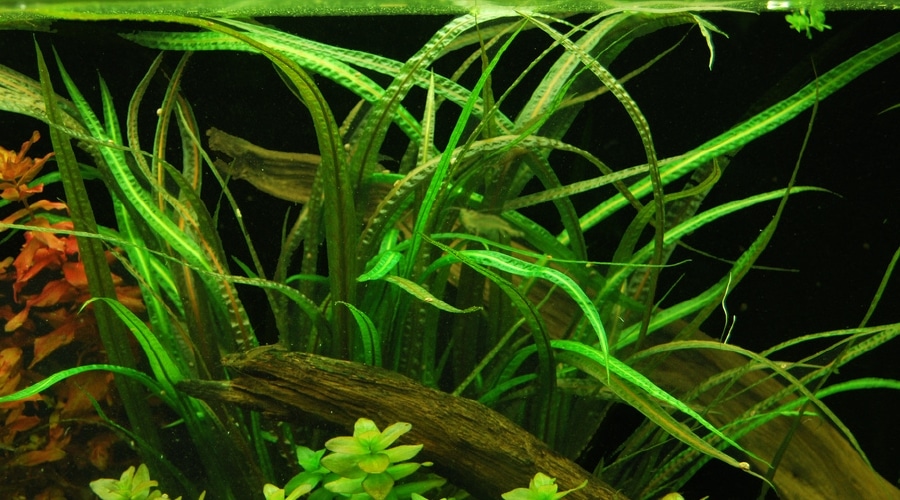
The leaves of the crypt balansae are long and thin with unique ruffled edges. The plant tends to form in dense clumps which provides suitable hiding places for aquatic animals.
This plant is a relatively slow grower, but is worth the effort for the unique texture and appearance. C. Balansae makes a great mid to background plant.
- Light level required: Moderate-High light.
- Level of care: Intermediate. Highly sensitive to changing conditions within the aquarium.
- Compatibility: Good but should not be included in tanks with cichlids who may tear up the leaves.
13. Crypt Spiralis

Another of the Crypt genus, the crypt spiralis displays long thin leaves which form loose spirals as they grow up to 24" in length. The leaves of spiralis are slightly thicker than the other Crypts, and while it grows slowly it will still tend to sprout shoots throughout the aquarium.
- Light level required: Moderate.
- Level of care: Beginner-Intermediate. Highly sensitive to changing conditions within the aquarium.
- Compatibility: Good but should not be included in tanks with cichlids who may tear up the leaves.
14. Guppy Grass (Najas guadalupensis)

Guppy grass got its name due to its utility as a "nursery" plant for baby guppies. It has thin green leaves that grow in dense clumps. This plant tends to float in the tank and will grow steadily.
For sheer flexibility, it's hard to beat Guppy Grass. Whether you want to root it, let it float, use low light or high, the plant will thrive in any sort of aquarium!
- Light level required: Any; low is sufficient.
- Level of care: Beginner.
- Compatibility: Excellent, especially for baby guppies!
15. Anubias Barteri

Anubias barteri has large arrow or heart shaped leaves that are bright green in color and have rippled edges.
This plant stays relatively small, approximately 6" in height and 5" in width. It is a slow-growing plant with hearty, tough leaves that are bitter and unpleasant for most plant eating fish and invertebrates.
The broad leaves tend to encourage algae growth, however. Pairing Anubias with algae eating fish and invertebrates will help keep these showy plants looking their best.
- Light level required: Low-moderate light.
- Level of care: Beginner.
- Compatibility: Excellent; hearty enough to withstand even the most plant-loving of aquarium dwellers.
16. Anubias Nana

Anubias nana is the smaller relative of A. barteri, though both species have large leaves relative to the overall size of the plant. Nana is a low, bushy, slow spreading plant which attaches itself to driftwood or other objects in the aquarium. Like barteri, it features arrow shaped leaves, and the plant stays relatively small.
Anubias species make great additions to aquariums with plant eating fish. The large, rubbery leaves are quite bitter and tough; few fish and invertebrates will bother an establish Anubias plant.
- Light level required: Low light.
- Level of care: Beginner.
- Compatibility: Excellent; hearty enough to withstand even the most plant-loving of aquarium dwellers.
17. Pelia (Monosolenium tenerum)

Though Pelia is visually quite similar to a moss, it is a distinct plant which serves different purposes from most mosses. Unlike moss, Pelia does not attach itself to structures and grow rapidly in thick mats. Pelia sinks naturally, and can be allowed to free float or can be anchored down using netting or fishing line. Pelia is commonly used for aquascaping, and is a popular choice due to the unique structure of its shoots.
- Light level required: Low-Moderate light.
- Level of care: Beginner-Intermediate.
- Compatibility: Moderate. Should not be included in tanks with rough or schooling fish, which may easily damage the brittle Pelia.
18. Waterwheel Plant (Aldrovanda vesiculosa)

The waterwheel is among the most exotic of the aquatic plants discussed thus far. It has been likened to an aquatic Venus fly trap, an appropriate comparison due to the small carnivorous traps at the end of each whorl (or "spoke") of the plant. The waterwheel feeds on aquatic insects, and tends to free-float on the surface of the water in order to "hunt" for its prey.
- Light level required: Moderate to Full.
- Level of care: Intermediate-Advanced.
- Compatibility: This plant requires a diet of meat, supplied through daphnia, insects, snails, tadpoles, mosquito wigglers, etc. This must be considered prior to introducing the plant to an aquarium.
19. Bacopa (Bacopa caroliniana)

Another classic aquatic plant, the Bacopa is recognizable by its oblong leaves which grow opposite each other, creating a "ladder" up each stalk. The Bacopa varies in color from bright greenish-yellow to brown, and it must be provided with a sufficient substrate to take root in. It is a slow growing plant which can reach up to 12 inches in height.
- Light level required: Low-Moderate.
- Level of care: Beginner.
- Compatibility: Excellent.
20. American Waterweed (Elodea canadensis)

Elodea is a fast growing long stemmed plant which takes well to being floated or rooted in substrate, and provides sufficient cover for small fish.
The elodea can be seen commonly growing naturally in ponds and lakes in North America. It is a food staple for many aquatic animals such as ducks, turtles, beavers, etc.
However, it is considered an invasive species in some states, so local laws must be consulted prior to introducing this plant to an aquarium.
Vegetarian fish absolutely love Elodea for its soft leaves and rapid growth.
- Light level required: Low light.
- Level of care: Beginner.
- Compatibility: Good, but many fish and aquatic animals seek out elodea as a main food source. Should not be included in tanks with fish who feed on soft plants, unless the plant is being provided as a food source!
21. Micro Crypt (Cryptocoryne petchii)

Like the crypts described above, the micro crypt is a slow growing plant with thin, long leaves which feature ruffled edges. The micro is the smallest of the crypt varieties, only attaining a full size of a few inches in height.
Like other dwarf crypts, C. petchii inhabits swift flowing, shady streams in Sri Lanka. While slow growing it's also quite hardy and undemanding.
Many crypts can be purchased as bulbs in pet stores, which allows you to properly establish a healthy root system for your new plants over time!
- Light level required: Low light.
- Level of care: Beginner.
- Compatibility: Good but should not be included in plants with cichlids who may tear up the leaves.
22. Red Ludwigia (Ludwigia repens)

The Red Ludwigia is a favorite for the bright red foliage it displays in the proper lighting. It is a stem plant which grows quickly and requires regular pruning. Often, large groups of shoots are planted together. It is commonly included in the foreground of aquariums and it easy to maintain once planted in substrate.
As a North American native, Red Ludwigia is tolerant of cooler water temperatures as low as 65 degrees but prefers things on the warmer side, from 75 to 80 degrees. Once well established and given occasional feedings, it takes on a ruddy color on the underside of its leaves.
- Light level required: Moderate; too low light will cause loss of leaves and diminish the color.
- Level of care: Beginner.
- Compatibility: Excellent.
23. Marimo Ball
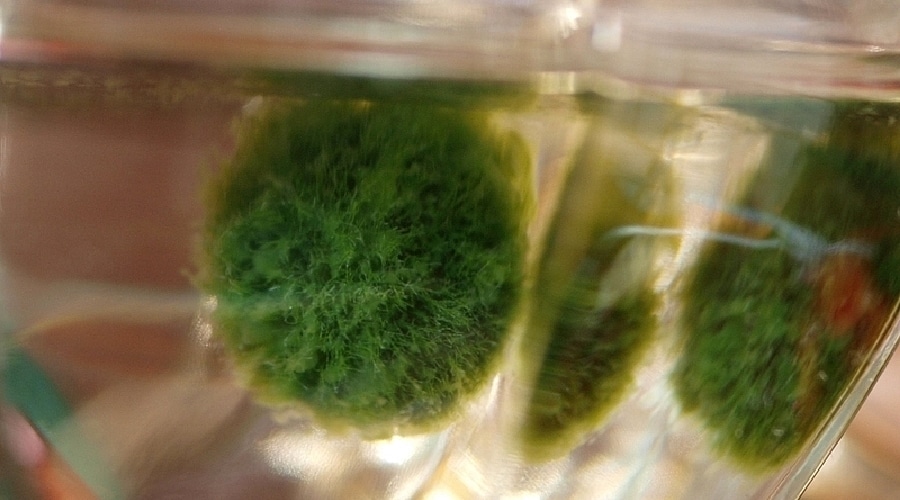
Commonly mistaken for a moss, the Marimo is actually a strain of spherical algae which grows outward radially, naturally forming a ball shape. These low light aquarium plants grow very slowly, but are incredibly easy to care for and have long lives. They are a favorite for their unique appearance, and are commonly used as décor.
Marimo Moss Balls prefer some current to maintain their shape. In low light aquariums without powerheads or strong filtration, they may flatten out over time. They also prefer cool, clean water, similar to the pristine ponds they originate from. Overfertilization can kill these somewhat sensitive aquatic plants.
- Light level required: Low light to avoid browning.
- Level of care: Beginner.
- Compatibility: Excellent, but monitor to ensure that the fish are not overeating the marimo ball and disturbing its growth. Popular choice for betta tanks, should not be used in goldfish tanks.
24. African Water Fern – (Bolbitis heudelotii)

African water ferns are a robust plant with long stalks are delicate dark green leaves. The fern grows very slowly, but can grow up to 16-18". African water ferns anchor themselves to rocks, bark, or substrate, and will naturally tether themselves.
African Water Ferns are great low light plants but do prefer supplemental feeding and CO2 on occasion for the best growth.
- Light level required: Low-Moderate.
- Level of care: Beginner.
- Compatibility: Excellent, especially when paired with algae-eating fish or shrimp.
25. Coffee leaf anubias – (Anubias barteri v. 'coffeefolia')
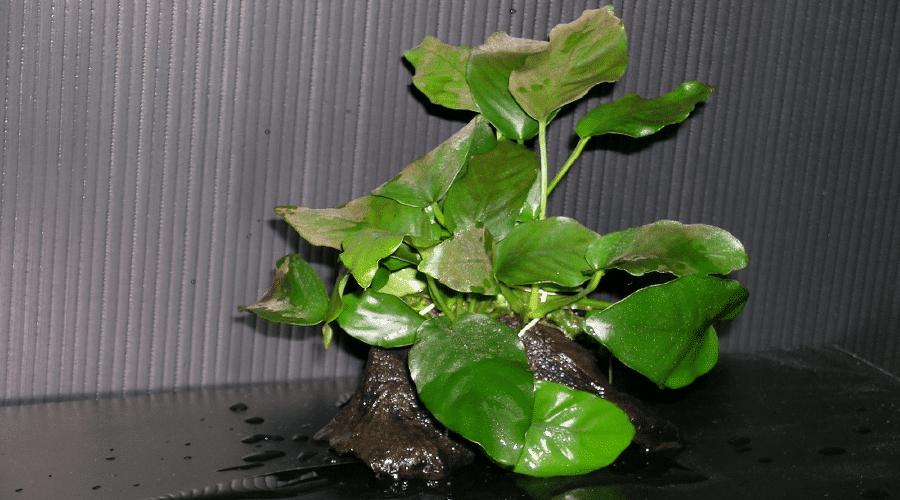
The coffee leaf anubias is known for its oblong rippled leaves which spread out from the plant, growing wide rather than tall. The young leaves are a mocha brown that eventually transforms to the dark green Anubias are known for.
Like other Abubias species, Coffee leaf anubias tend to grow quite slowly, and should not be planted into the substrate as burying the rhizome usually kills the plant.
All Anubias species prefer being anchored to driftwood, rocks, or even filter piping! Simply take a rubber band and secure the young Coffee Leaf Anubias; by the time the band decays, the plant will be securely anchored!
- Light level required: Low light.
- Level of care: Beginner.
- Compatibility: Excellent, especially when paired with algae-eating fish.
26. Duckweed

Duckweed (Lemnaceae) are a contentious plant. It does incredibly well as a low light aquarium plant because it sits directly at the surface of the water to soak in light. And thanks to its abundant growth and ability to tolerate nearly any water conditions, it will form a green carpet reminiscent of some Florida swamp in your tank. The benefits are that it acts as an incredible nutrient sponge, soaking up organics that would otherwise fuel algae and other undesirable growth.
Some aquarists pair duckweed with submerged plastic plants or extreme low light tolerant plants like Java Moss or Java Fern.. The duckweed creates shade, a beautiful natural look, and works as a biological filter. Just bear in mind that if you decide to get rid of it, you have to be incredibly thorough or it can regenerate from even a single remaining plant!
- Light level required: Low
- Level of care: Very Easy
- Compatibility: Great nutrient sponge and algae control plant; beware it's propensity to grow out of control!
27. Banana Plant (Nymphoides Aquatica)

Banana Plants are not as hardy as some of the other plants here because they actually prefer moderate lighting. However, they work well in low light aquariums due to their banana shaped root appendages. These specialized tubers hold extra nutrients for lean times, which the plant will tap to create a lilypad-like leaf that will shoot to the surface for optimal light exposure.
While brighter lighting will encourage the Banana Plant to create more underwater foliage with an attractive purplish red shade, it will quickly send up a number of lily pad leaves if kept in a low light aquarium.
- Light level required: Low-Moderate.
- Level of care: Easy
- Compatibility: Suitable for all aquariums; beware of snails as they love to consume the fleshy tubers, which kills the plant.
28. Water Wisteria (Hygrophila Difformis)

While Water Wisteria will grow well in a low light aquarium, be aware that its growth form varies depending on the lighting. It takes on a broad leafed form to maximize light exposure until moved into a high light environment, where it transforms into a fine, almost feathery leafed plant that looks like an entirely different species!
Water Wisteria is slightly more demanding in terms of nutrition, preferring supplemental CO2 and fertilization to achieve optimal growth.
- Light level required: Low-High.
- Level of care: Intermediate
- Compatibility: Great and takes on different appearances based on light and nutrient levels.
29. Lemon Bacopa (BACOPA CAROLINIANA 'LEMON BACOPA')

A slow growing stem plant, Lemon Bacopa prefers being planted in small groups where it will work its way to the surface and even produce a small purple flower. The crushed leaves have a distinctly lemony scent, hence the name. Easy to care for and not requiring much in the way of lighting or supplemental feeding, Lemon Bacopa is one of the finest low light aquarium plants in the market.
Lemon Bacopa is incredibly easy to propagate; simply take a cutting and insert it into the gravel. Within a few days, the new shoot will sprout roots that will work its way into the substrate as a new plant.
- Light level required: Low-Moderate.
- Level of care: Easy
- Compatibility: Fits well in most tanks; has a pleasant smell when crushed!
30. Peacock Moss

Taxiphyllum sp. "Peacock" is a relative newcomer to the exciting world of aquatic mosses. WIth a slightly blue-green coloration and a tidy growth pattern similar to a miniature pine tree, Peacock Moss is a hardy, yet attractive alternative to Java Moss as a low light aquarium plant.
While just as hardy, it does grow somewhat slowly, meaning it takes far less maintenance to keep looking good.
Peacock Moss does appreciate occasional fertilization and even CO2 if kept in a fully planted aquarium. Peacock Moss is also a cooler water low light plant, preferring temperatures no higher than 75 degrees.
- Light level required: Low
- Level of care: Intermediate
- Compatibility: Tidy compared to Java Moss; low light is essential to this shade-dwelling aquatic moss.
Final Thoughts
Picking out a good mixture of low light aquarium plants is a very important step for beginners.
By following our all-inclusive guide, aquarium owners of any skill level should be able to set up a diverse, compatible flora ecosystem is their tank.
Even though most of the species we have covered in this guide have relatively low-light requirements and tend to be easy to keep alive, remember to always take proper care of your aquarium.
Weekly or bi-weekly water changes are a must, especially for those who decide to keep plants.
With the proper care the a good set up, your planted aquarium will thrive for years to come!
starlingceitheart1948.blogspot.com
Source: https://www.buildyouraquarium.com/low-light-aquarium-plants/

0 Response to "Easy to Grow Low Light Aquarium Plants Nano"
Post a Comment